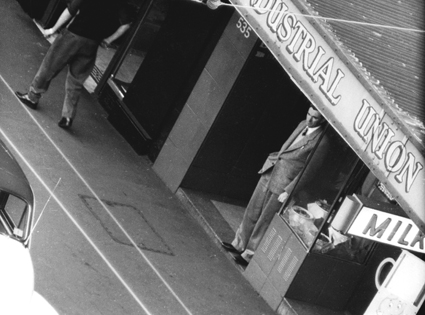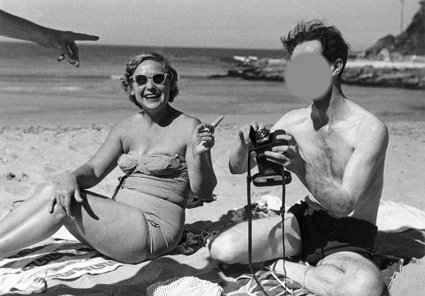Cautionary tales: under the eye of ASIO
Dan Edwards: Haydn Keenan’s Persons of Interest

ASIO surveillance photo, Frank Hardy, George St Sydney
courtesy Australian National Archive
ASIO surveillance photo, Frank Hardy, George St Sydney
An intelligence agency out of control. Australian artists defending totalitarian regimes. Volunteer spies led on for decades and then left in the cold. Haydn Keenan’s four-part documentary Persons of Interest offers a wealth of cautionary tales whichever way you look at it. Glib confidence or conspiratorial fears are rarely far from the frame when the Australian Security Intelligence Organisation (ASIO) is discussed in public, so Keenan is to be commended for putting together a complex portrait. Unfortunately some of the reactions to his series during its broadcast on SBS last month highlight a distinct lack of critical nuance in our contemporary culture.
Keenan’s premise is simple enough—hand four aging radicals their declassified ASIO files and garner their reactions. Then tease out the files to tell the story of post-war dissent in Australia and governmental efforts to contain perceived political threats. Three of the episodes focus on Communists: Roger Milliss and his deceased father Bruce, former Monash Labor Club Maoist Michael Hyde and the Australian writer Frank Hardy. The fourth subject is the inimitable Gary Foley, a central figure in the Indigenous land rights movement of the late 1960s and early 70s.
The files reveal a depth of surveillance that is at times almost comical. Foley sneaking off for a dirty weekend with a leftist in the early 70s is cited as evidence of a Black Power-Communist Party plot. Frank Hardy’s drunken night out with Soviet poet Yevtushenko and a former Bond girl—complete with a drunken unsuccessful pass by the Russian writer—is described in breathless detail. Every car trip across town by certain persons of interest is recorded in minute detail.
Then there’s the footage. Keenan was spared any reliance on historical re-enactments by the availability of hundreds of hours of ASIO surveillance films in the national archives. We see May Day parades of the 1950s, anti-Vietnam War protests of the late 1960s and Communist Party congresses across the decades. At times the footage is almost Warhol-esque in its unrelenting gaze. There are countless hours of footage of the entrance to the Australian Communist Party’s Sydney headquarters, the street remaining fixed as fashions, cars and faces transform with the passing years. Unfortunately the demands of broadcast television prevented any lingering on this footage and the mute history it contains. I kept imagining another kind of film, or video installation, compiled from this material that dwelt on the sheer fascinating banality of the surveillance images.
We certainly saw enough footage to convey the breadth and depth of surveillance carried out by ASIO in the post-war era, and much of the press coverage that greeted Persons of Interest focused on this disquieting aspect of the series’ revelations. In contrast, Gerard Henderson in The Australian saw fit to leap to ASIO’s defence, extolling the agency’s work against those who “want to overturn the state” (“Totalitarian slurs ignore the truth of ASIO activities,” January 11, 2014). Henderson correctly points out that the Soviets were running a spy ring in 1950s Australia and prominent figures involved in the Labor Party were covert members of the Communist Party—all of which the series details. But Persons of Interest also shows how an intelligence organisation operating without external oversight, under a Menzies Government intent on milking fears about Communism to maximum political advantage, became a deeply paranoid, highly politicised and extremely invasive spying machine. While some of those under surveillance expressed a desire to carry out violent political actions, the files also clearly demonstrate that ASIO was incapable of distinguishing subversive threat from legitimate political dissent or even cultural curiosity. Prominent film critic David Stratton, for example, earned a file in 1969 after visiting the Soviet Embassy to obtain a visa to attend a film festival.

Mrs Petrov at the Beach with an ASIO officer
courtesy Australian National Archive
Mrs Petrov at the Beach with an ASIO officer
Stratton’s case was not atypical. ASIO opened files on literally hundreds of thousands of Australians in the post-war era, especially in the arts. Everyone from novelist Christopher Koch to actor Peter Finch appears in the archives. Merely knowing a person of interest was enough to earn a file, creating an ever expanding net of surveillance. The result? A pretty fundamental misreading of what was happening in Australian society from the 1950s to 70s and a colossal waste of time, effort and taxpayer-funded resources. It’s ironic that Henderson is offended that Persons of Interest received public funding when the millions ASIO mis-spent spying on prominent writers, painters, actors, politicians, judges and unionists who have contributed immensely to Australian public life doesn’t seem to bother him at all.
There is another cautionary tale here though, which has received less attention in the more liberal press. As the stories in Persons of Interest show, much of Australia’s hard left in the post-war era was beholden to Moscow, with creative figures like Frank Hardy defending the indefensible with the invasion of Hungary, the suppression of the Prague Spring and Stalin’s mass slaughter of Soviet citizens. When the Communist movement ruptured in the wake of the Sino-Soviet split of the late 1950s, figures like Bruce Milliss passionately defended Mao’s even more murderous regime. We see Bruce’s son Roger bitterly denouncing the “filth” on his ASIO file regarding his personal life, yet neither he nor his wife appears to reflect upon the work they did for the Soviets, which extended to propagandising for the regime in Moscow while working for Soviet media. They are rightly appalled by the extent to which ASIO pried into and recorded their private lives, but why do they appear so forgiving of regimes that were far, far worse in their crimes?
The most striking lesson offered by Persons of Interest—and the one least discussed in the press—is the danger of blind faith in any doctrine, regime or organisation, whether it’s ASIO or the Communist Party of Australia. All these organisations are essentially bureaucracies and all bureaucracies have a natural propensity to become self-justifying and self-perpetuating. They also render many of those within these organisations blind to anything that does not conform to their worldview. Australian Communists refused to see what was unfolding in the Eastern Bloc and Mao’s China, just as ASIO interpreted every post-war social movement as evidence of a global Communist plot.
ASIO files remain classified for 20 years (until recently it was 30), so Persons of Interest could not touch on the agency’s contemporary activities. Suffice it to say ASIO’s budget is now at record levels and its legal powers far greater than they were in the post-war decades. Anyone can now be secretly arrested for a week without charge with no right to silence. If Australia has avoided the worst forms of political repression it’s not because the likes of ASIO have protected our interests, as Gerard Henderson would have us believe. It’s because some in our legal, political and cultural professions have had the courage to watch the watchers, and help keep their powers and paranoia in check. Organisations like ASIO are arguably necessary even in a democracy. What’s less in doubt is that publicly funded documentaries like Persons of Interest are essential.
Persons of Interest, four-part series, director Haydn Keenan, producer Gai Steele, Smart Street Films, SBS ONE, 7-28 January 2014.
RealTime issue #119 Feb-March 2014 pg. 18






